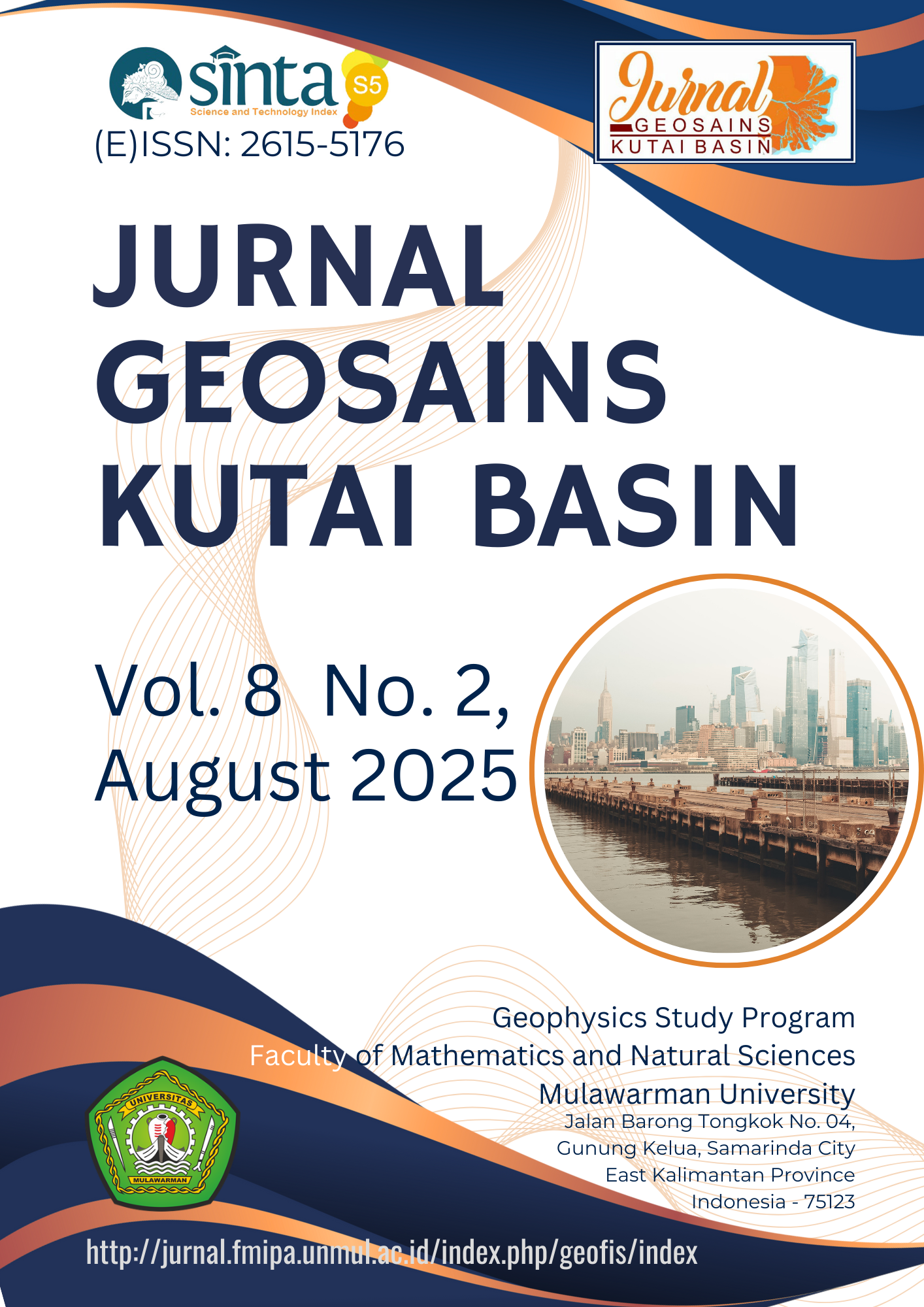Investigasi Deformasi Permukaan Tanah Pasca Gempabumi Myanmar 7.7 Mw 2025 Menggunakan Metode Differential Interferometry Syntetic Aperture Radar
DOI:
https://doi.org/10.30872/52yjec35Keywords:
Deformasi, DInSAR, Gempabumi Myanmar 7.7 Mw, Sentinel-1Abstract
Penelitian ini bertujuan untuk menginvestigasi deformasi permukaan tanah yang terjadi pasca gempa bumi Myanmar berkekuatan 7.7 Mw pada 28 Maret 2025. Sepasang data citra Sentinel 1A dan 1B digunakan dalam mengamati perubahan tanah sebelum dan setelah terjadinya gempa utama. Metode yang digunakan dalam penelitian ini yaitu Differential Interferometric Synthetic Aperture Radar (DInSAR), yang mampu mendeteksi perubahan kecil pada permukaan bumi dengan resolusi spasial tinggi. Data citra satelit Sentinel-1 diolah untuk menghasilkan interferogram yang menunjukkan pola deformasi. Hasil analisis menunjukkan adanya pergeseran permukaan tanah signifikan di sepanjang zona sesar aktif Sagaing dengan arah dominan pergeseran horizontal dan vertikal yang bervariasi. Deformasi maksimum terdeteksi di sekitar lokasi gempa utama mencapai -25 cm relatif mengalami penurunan muka tanah (subsidence) terhadap line of sight. Disisi lain terjadi kenaikan muka tanah (uplift) maksimum sebesar +2.3 cm terhadap line of sight di bagian barat daya Sesar Sagaing dan pusat gempa 7.7 Mw. Distribusi nilai deformasi menunjukkan orientasi yang sesuai dengan model mekanisme sumber gempa sesar geser menganan. Hasil uji model juga menunjukan kesesuaian citra yang akurat dengan nilai koherensi sebesar 0.6 hingga 0.9.
Downloads
References
[1] Aung, W. Y., Gautam, S., & Gautam, D. (2025). Damage mechanisms and seismic vulnerability of building structures following the 2025 M 7.7 Mandalay earthquake sequence, Myanmar. Engineering Failure Analysis, 109849.
[2] Cai, J., Xi, N., Han, G., Deng, W., & Sun, L. (2025). Rapid report of the March 28, 2025 Mw 7.9 Myanmar earthquake. Earthquake Research Advances, 100396.
[3] Wang, T., Zhou, Y., Chen, J., Wang, X., Bi, H., & Wang, X. (2025). Field survey of building damage at Mandalay during the 2025 Myanmar Mw 7.7 earthquake. Earthquake Engineering and Engineering Vibration, 1-15.
[4] USGS (2025), U.S. Geological Survey Earthquake Event Page, https://earthquake.usgs.gov/earthquakes/eventpage.
[5] Wang, Y., Sieh, K., Tun, S. T., Lai, K. Y., & Myint, T. (2014). Active tectonics and earthquake potential of the Myanmar region. Journal of Geophysical Research: Solid Earth, 119(4), 3767-3822.
[6] Aung, P. S., Satirapod, C., & Andrei, C. O. (2016). Sagaing Fault slip and deformation in Myanmar observed by continuous GPS measurements. Geodesy and Geodynamics, 7 (1), 56-63.
[7] Phattharapornjaroen, P., Burivong, R., & Khorram-Manesh, A. (2025). Myanmar Earthquake Aftermath–Critical Update and Expanded Analysis. Disaster Medicine and Public Health Preparedness, 19, e125.
[8] Azhari, M. F., Karyanto, K., Rasimeng, S., & Mulyanto, B. S. (2020). Analisis Deformasi Permukaan Menggunakan Metode DInSAR (Differential Interferometry Synthetic Aperture Radar) Pada Studi Kasus Gempabumi Lombok Periode Agustus 2018. JGE (Jurnal Geofisika Eksplorasi), 6(2), 131–144.
[9] Crosetto, M., Monserrat, O., Cuevas, M., Crippa, B. 2011. Spaceborne Differential SAR Interferometry: Data Analysis Tools for Deformation Measurement. Journal of Remote Sensing, 3(2), 305-318.
[10] Fadhillah, M. F., Achmad, A. R., & Lee, C.-W. (2020). Integration of InSAR Time-Series Data and GIS to Assess Land Subsidence along Subway Lines in the Seoul Metropolitan Area, South Korea. Remote Sensing, 12(21), 3505.
[11] Boixart, G., Cruz, L. F., Miranda Cruz, R., Euillades, P. A., Euillades, L. D., & Battaglia, M. (2020). Source Model for Sabancaya Volcano Constrained by DInSAR and GNSS Surface Deformation Observation. Remote Sensing, 12(11), 1852.
[12] Rehman, M. U., Zhang, Y., Meng, X., Su, X., Catani, F., Rehman, G., Yue, D., Khalid, Z., Ahmad, S., & Ahmad, I. (2020). Analysis of Landslide Movements Using Interferometric Synthetic Aperture Radar: A Case Study in Hunza-Nagar Valley, Pakistan. Remote Sensing, 12(12), 2054.
[13] Wang, Z., Zhang, R., & Liu, Y. (2019). 3D Coseismic Deformation Field and Source Parameters of the 2017 Iran-Iraq Mw7.3 Earthquake Inferred from DInSAR and MAI Measurements. Remote Sensing, 11(19), 2248.
[14] European Space Agency (ESA), 2016. https://www.esa.int/Applications/Observing_the_Earth/Copernicus/Sentinel-1.
[15] Ferretti, A., Monti-Guarnieri, A., Prati, C., Rocca, F., & Massonet, D. (2007). InSAR principles-guidelines for SAR interferometry processing and interpretation (Vol. 19).
[16] Osmanoğlu, B., Sunar, F., Wdowinski, S., & Cabral-Cano, E. (2016). Time series analysis of InSAR data: Methods and trends. Isprs journal of photogrammetry and remote sensing, 115, 90-102.
[17] Yagüe-Martínez, N., Prats-Iraola, P., Gonzalez, F. R., Brcic, R., Shau, R., Geudtner, D., & Bamler, R. (2016). Interferometric processing of Sentinel-1 TOPS data. IEEE transactions on geoscience and remote sensing, 54(4), 2220-2234.
[18] Rajaram, C., Vemuri, J. P., & Singhal, S. (2025). Seismological Features and Preliminary Damage Assessment of the Devastating March 28, 2025, Myanmar Earthquake: A Comprehensive Overview. Available at SSRN 5219429.
[19] Socquet, A., Vigny, C., Chamot‐Rooke, N., Simons, W., Rangin, C., & Ambrosius, B. (2006). India and Sunda plates motion and deformation along their boundary in Myanmar determined by GPS. Journal of Geophysical Research: Solid Earth, 111(B5).
[20] Azhari, M. F., Nugraha, A. D., Zulfakriza, Z., Ry, R. V., Lesmana, A., Putra, A. S., ... & Saputra, H. S. (2023, September). Cianjur M5. 6 Earthquake Aftershock Survey (CEAS) Using ITB Temporary Seismographs. In IOP Conference Series: Earth and Environmental Science (Vol. 1245, No. 1, p. 012026). IOP Publishing.
Downloads
Published
Issue
Section
License
Copyright (c) 2025 GEOSAINS KUTAI BASIN

This work is licensed under a Creative Commons Attribution-ShareAlike 4.0 International License.


